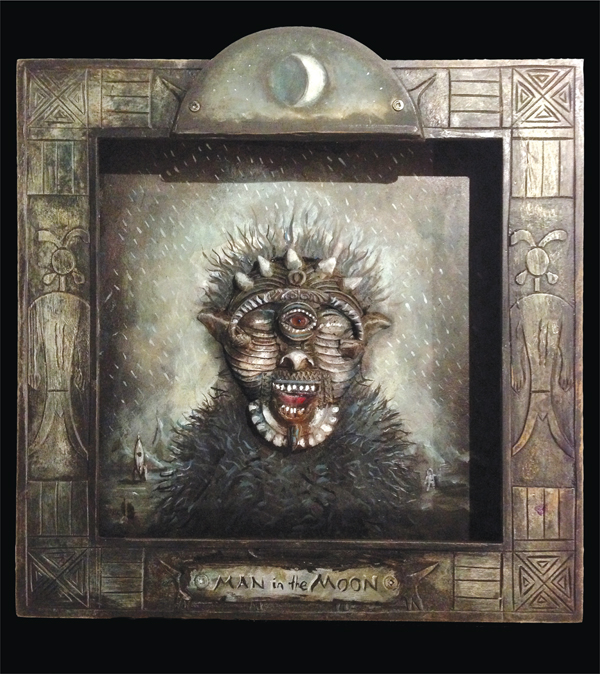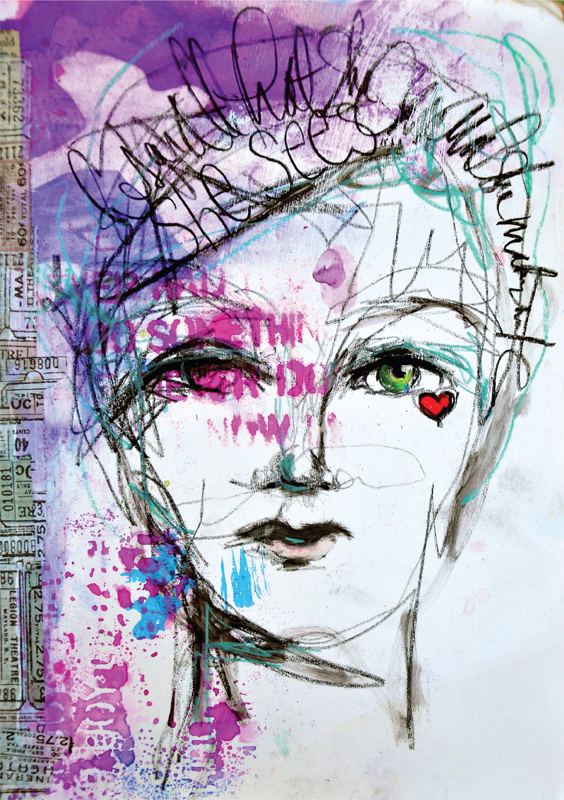

Seadusa
by Andrea Matus deMeng
acrylic, oil and collage on canvas
45" × 31" (114cm × 79cm)
“I am often asked about whether my faces are painted or collaged—they are both. Some completely painted, others collaged and painted over with some of the features changed along the way. I am also often asked about the color combinations I use in my work and how to achieve bold, vibrant paintings.”
—Andrea Matus deMeng
“I think I get more questions about the subject and story of the piece than about actual techniques. A favorite question is, of course, ‘How long did it take you to do that?’ I give artist James Whistler’s answer, ‘My whole life.’ People ask the most technique questions about mixed-media work such as ‘What glue do you use?’ ‘What kind of paint did you use?’ ‘How did you make her look so alive?’ If the portrait is done in encaustic, then I get lots of questions about what encaustic is and what the encaustic process entails.”
—Serena Barton

Man in the Moon
by Michael deMeng
mixed media on wood
14" × 12" × 3" (36cm × 30cm × 8cm)
“The one I get the most is ‘How does your brain come up with this stuff?’ You must understand that (A) I make things out of discarded things, and (B) my things are fairly demented looking when I get done.”
—Michael deMeng
“I am often asked what inspires my artwork. I’m inspired by everyone and everything that enters my path … the texture in a rusted chainlink fence, the beautiful shades of autumn leaves, bold colors of a vintage Hawaiian muumuu, the animals and nature I see during my daily walks, typography, vintage crafts or a conversation. I am open to taking bits and pieces of everyday life and incorporating them into my sketchbook, art journal or mixed-media creations.”
—Traci Bautista
“I am often asked how I make something transparent. My favorite technique when using acrylic paint is to mix acrylic medium or glazing liquid with a small amount of white. Test the transparency of the mixture first on a piece of scrap. The more white, the less transparency. Brush the mixture over the area that you want to look transparent. After the mixture is dry, you may brush over it with another mix using a color instead of white. Experimenting freely with this technique is the best teacher. There are infinite possibilities for adding layer upon layer of transparency at any stage in the process to create a visually rich surface.”
—Cindy Silverstein

She Wants
by Dina Wakley
acrylic and Stabilo pencil on journal paper
111⁄2" × 9" (29cm × 23cm)
“Many people ask me what art materials I use to draw my faces, especially, ‘What pencil is that?’ The pencil I use in my journal is the Stabilo All pencil. It is made to draw on paper, glass, plastic and metal. Since acrylic paint is plastic, the pencil works well and you can get a very dark line. It is water-soluble, too, so you can pull out shading or even wipe your drawing off altogether if you don’t like it. I sometimes call it the “magic pencil” because it makes you look better than you are when you draw.
“I also get asked a lot about white space. White space is an integral part of my art. White space is sometimes called negative space, and it is simply the area where your focal point is not. And white space does not need to be white. I have learned, though, that I like some space that is actually white in my work. By leaving some areas open, I can get away with more (i.e., more colors, more layers), because the eye has a place to rest. The white also makes the colors I use look more vivid.”
—Dina Wakley
“A question I often get asked is how to get over the fear of the blank page. I tackle it differently at times. Sometimes I simply squirt on some folk art paint onto a piece of cardstock and begin to scrape on the paint with a discarded credit card. Other times I might start doodling and let the doodles take me to where they want to go. If I listen very quietly and intently, I will hear my muse and her prompting … it might be to begin drawing a face … or it might be to begin with a scrape-painted background. It’s like I stop the process and ask internally, ‘Now what? What’s next?’ If I’m patient enough, I will hear my muse tell me what to do next. It’s always one grand adventure. I never know from one moment to the next what will happen. It’s so exciting.”
—Violette Clark

Do You Want My Presence
by Jane Davenport
acrylic, ink and colored pencil on 140-lb. (300gsm) hot-pressed paper
13" × 10" (33cm × 25cm)
“I love watching people when they first see my work ‘in the flesh’ because so many of them stroke the surface. There must be something invitingly tactile about it, making matte varnish a must! People lament that they can’t draw, and I always disagree. Of course they can draw—anyone can draw. I suppose they mean they can’t draw like the brilliant artist of their dreams, but can anyone if they don’t work at it? Maybe it’s because drawing is one of the first things we learn as children. And if we are not declared an art genius by age seven, we let it fall away as an impossibility. Drawing is so good for you because it engages so many parts of the brain from memory to imagination and hand-eye coordination. I believe drawing faces can serve the same purpose as dreaming … they can free you.”
—Jane Davenport
“Some people ask me, ‘How do you think things like that up?’ I don’t think my way into or through a painting; it’s more about intuition and feeling. As I paint, things arise. When something arises that I feel connected to, then I continue in that direction.
“I am also asked how frequently I paint. It varies. I go through spells where I’m painting many hours a day most days (especially in the winter when it’s rainy here in the Pacific Northwest), but when it’s sunny and warm, you’ll find me working outside in the garden. I go with the ebb and flow and follow my passion.”
—Katie Kendrick
“I am frequently asked, ‘Where do you get your ideas?’ My ideas are a rich brew of many experiences. I love to look at people’s faces and am a student of facial features and expressions. I love to collect color combinations that inspire me from the natural and material world. I rarely draw from a reference photo. I often play some favorite music, relax and see what comes out of the end of my pencil.”
—Kate Thompson

Heidi
by Mindy Lacefield
acrylic, mixed media on board
10" × 8" (25cm × 20cm)
“A question that I get asked frequently is how did I come up with my style. My answer is always, ‘All by mistake.’ While I was painting a face one day, I had a piece of bleeding blue tissue paper that was covering one side of the face. I kept trying to paint over it, but the tissue paper has ink in it that tends to keep showing through, no matter how much you try to paint over it. Frustrated with the process, I set it aside and came back to it the next day. When I revisited it that next morning, I realized that the blue color really served to help mold and make the side of the face go back in space. Since cool colors recede, it seemed to work! It helped the face seem to be not as flat and more dimensional. I am so thankful for that happy accident and ‘mistake’ because now I paint blues and greens on the sides of the face on purpose.”
—Mindy Lacefield
“I am often asked how I am able to convey such feelings with the portraits I make. This question is very difficult to answer. Every person who views art is going to see it and feel it differently. I do put quite a lot of myself, my moods and current events in my life into my work. Maybe people pick up on that and can relate? I tend to paint mostly women, so I think I convey more regarding women’s issues. I use facial expressions, body language and hand gestures to express what might be going on with the subject. Sometimes it’s the title that says just as much as the art itself. In fact, sometimes I know right away what the title will be and will paint to that. Other times, I will be finished with the painting and have to look at it for some time prior to naming it.”
—Jane Spakowsky

Albert in His House
by Sunny Carvalho
acrylic, fabric, mixed media on birch panel
36" × 24" (91cm × 61cm)
“Most of the questions that I get are more about imagination and inspiration than specific techniques, although I do often get questions about certain effects such as, ‘How did you get the lightness in this area?’ I also get a lot of questions about how I paint the eyes of my characters.”
—Sunny Carvalho
“Sometimes people ask, ‘How long does it take to create?’ The time it takes to create can range from as short as a few minutes to do a quick sketch all the way to weeks to work on a piece that is still in need of just the right element. When I’m asked, ‘Where do you find time to do this?’ I respond that I make the time, because engaging in the creative process is critical to my sense of well-being.”
—Cynthia Stroo
“I’d have to say, ‘What colors do you use for skin tones?’ has been asked most frequently. Typically my color palette tends to be cool, even when it comes to skin tones. I use Titanium White, Alizarin Crimson and Quinacridone/Nickel Azo Gold.”
—Misty Mawn